Abstract
Two different monoclonal antibodies directed against Legionella micdadei and L. dumoffii (Genetic Systems Corp., Seattle, Wash.) were evaluated for their specificity and ability to detect L. micdadei and L. dumoffii in human and animal clinical samples and bacterial isolates in an indirect immunofluorescence assay. All three frozen sputum samples and all three Formalin-fixed sputum and liver samples from patients with culture-documented L. micdadei pneumonia were positive when tested with the L. micdadei monoclonal antibody. A Formalin-preserved lung sample from a patient with culture-documented L. dumoffii pneumonia was positive with its homologous monoclonal antibody. No cross-staining reactions were found with either monoclonal antibody on any of 25 human sputum samples tested from patients without Legionella infections. A total of 66 Legionella strains and 56 non-Legionella strains including 22 Pseudomonas strains and 34 other bacterial strains were studied. No cross-staining reactions were found except in Staphylococcus aureus Cowan 1 ATCC 12598. The lower limit of detection in seeded sputum samples was about 7 X 10(4) cells per ml for both monoclonal antibodies. Lung and tracheal lavage specimens from L. micdadei- or L. dumoffii-infected guinea pigs showed specific staining only with their respective monoclonal antibodies. The monoclonal antibodies stained homologous bacteria slightly less intensely than did the polyclonal antisera, but the signal-to-noise ratio was considerably higher for the monoclonal antibodies. No differences in sensitivity of staining of clinical specimens or bacterial isolates were noted between the monoclonal antibodies and the polyclonal reagents for L. micdadei and L. dumoffii (Centers for Disease Control, Atlanta, Ga., and BioDx, Denville, N.J. These monoclonal antibodies ae sensitive and specific, making them good candidates for laboratory diagnostic purposes.
Full text
PDF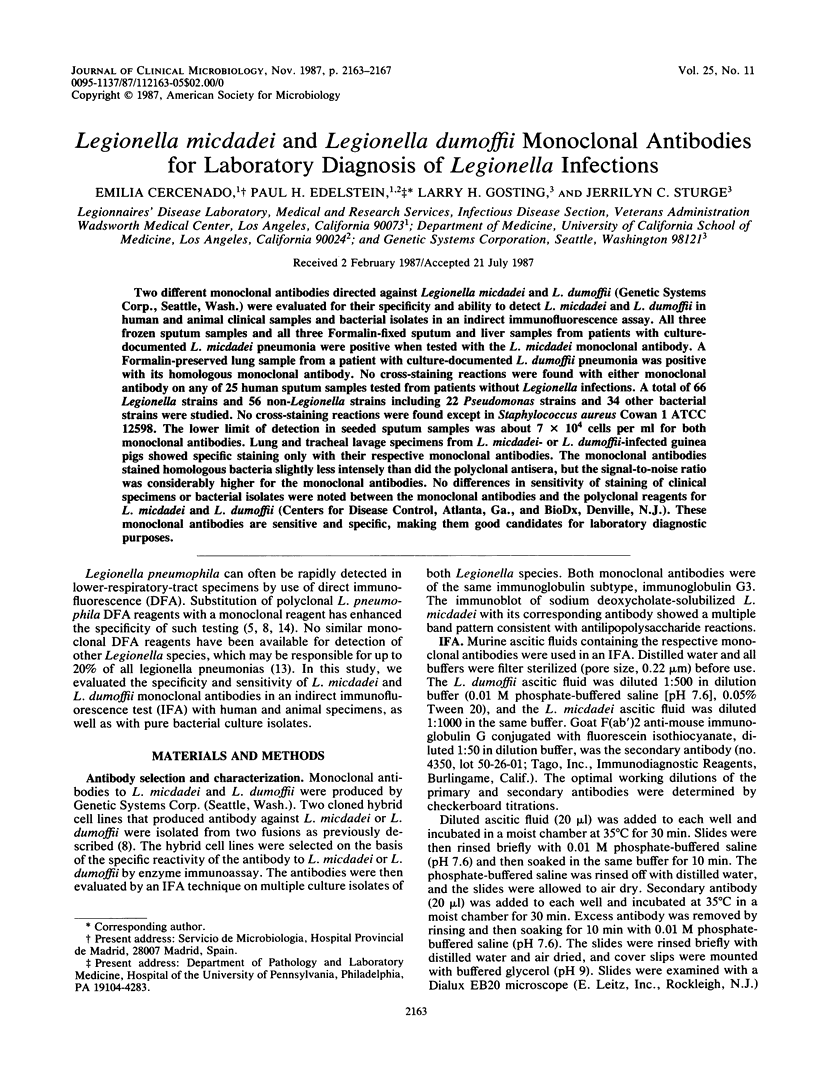
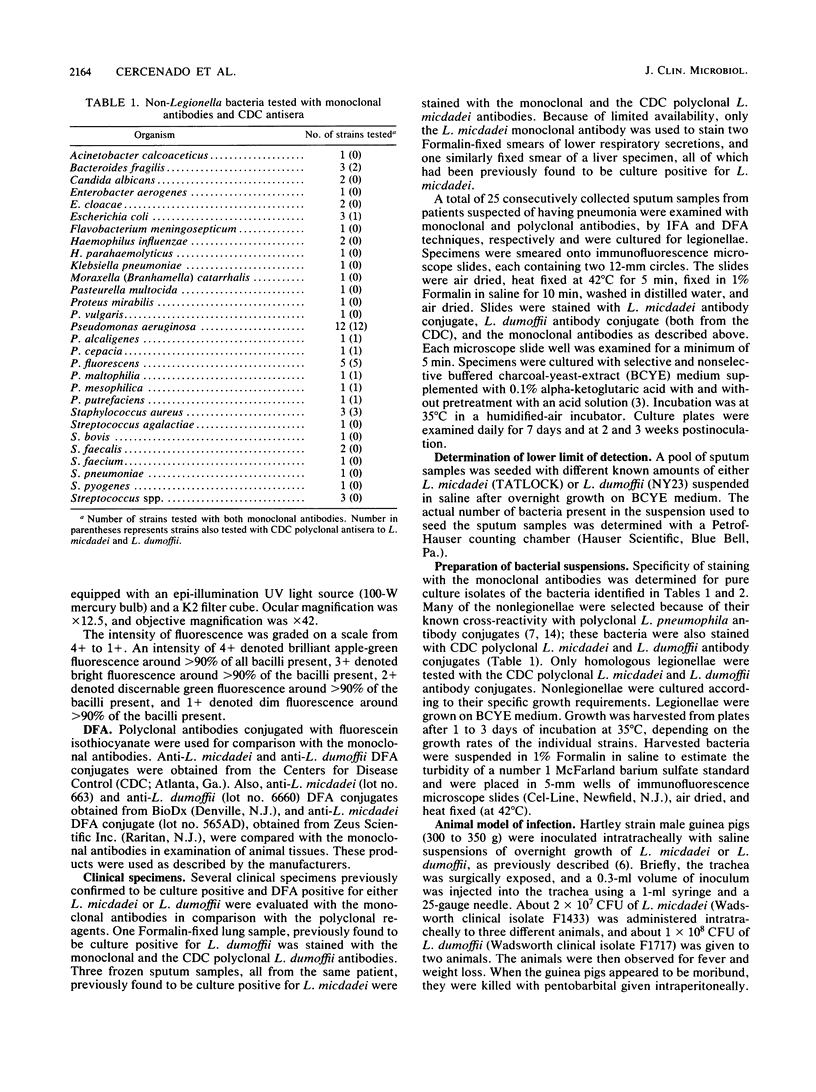
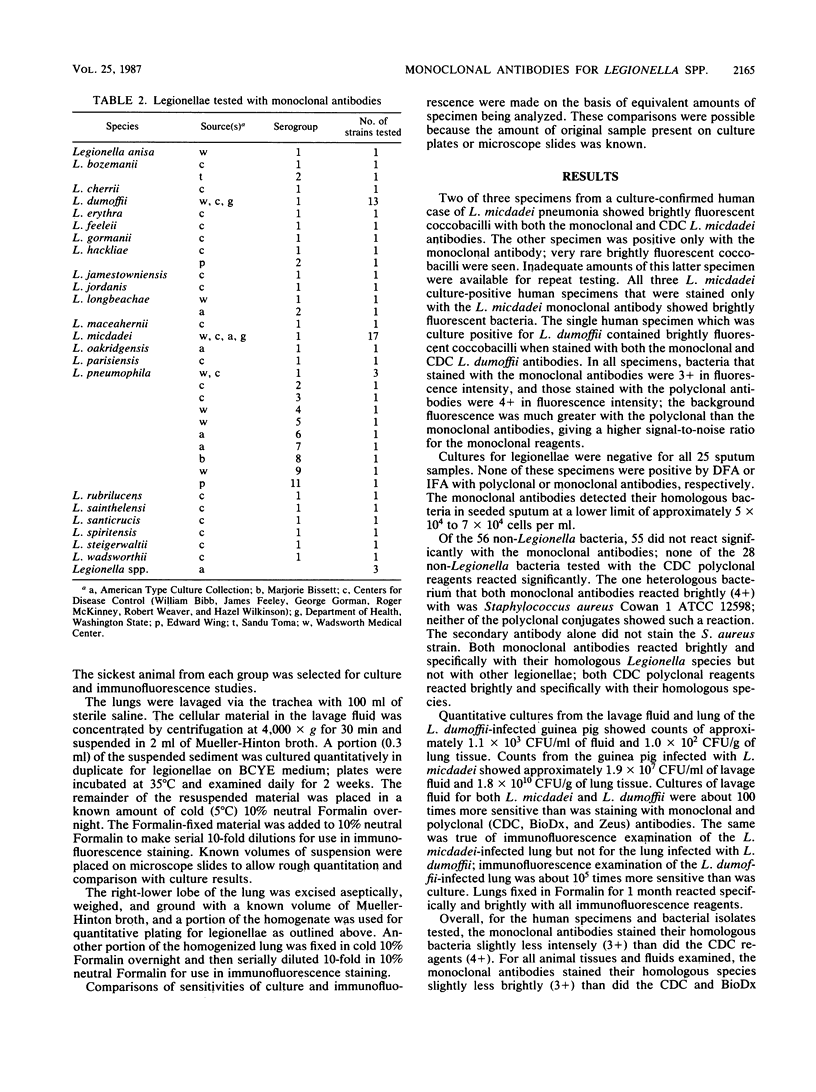
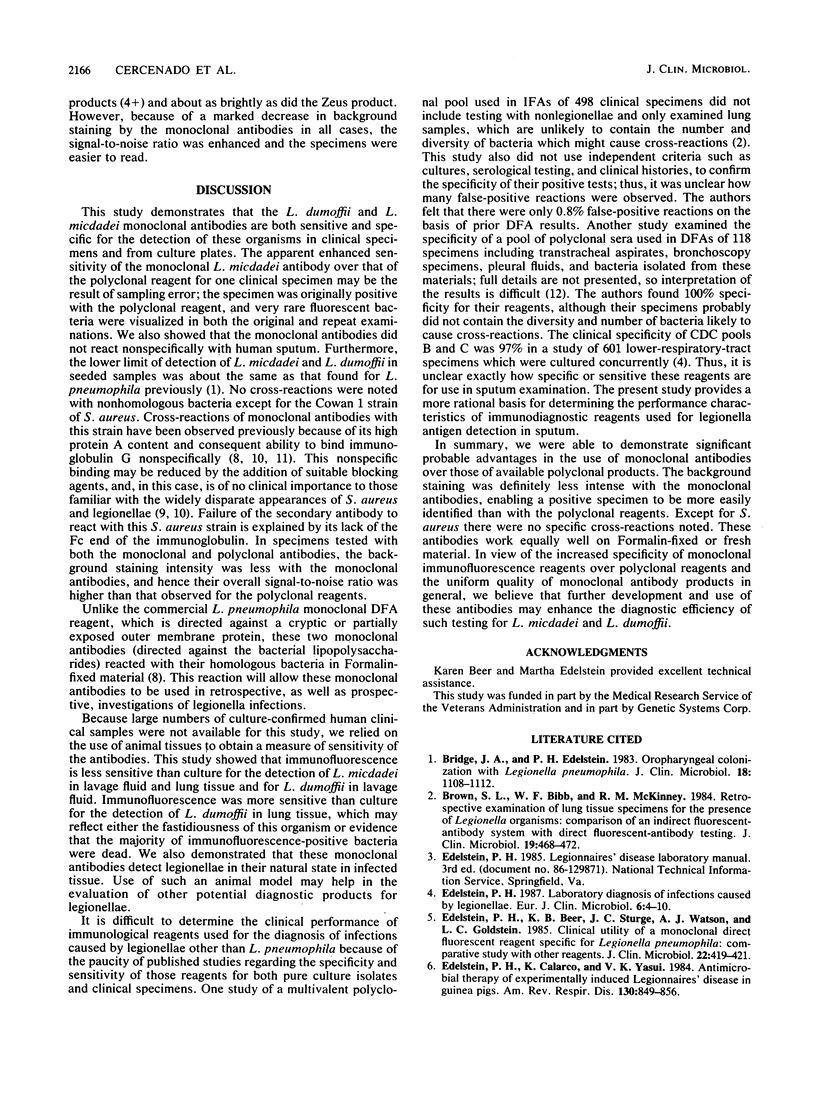
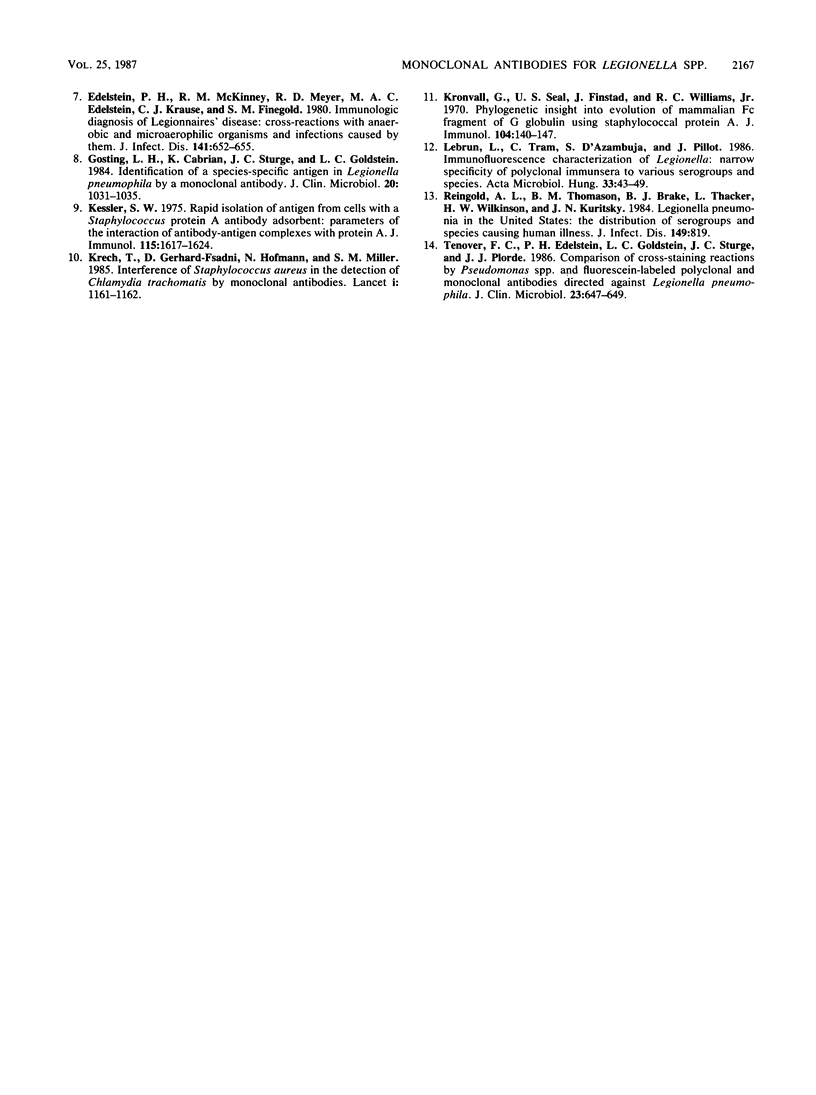
Selected References
These references are in PubMed. This may not be the complete list of references from this article.
- Bridge J. A., Edelstein P. H. Oropharyngeal colonization with Legionella pneumophila. J Clin Microbiol. 1983 Nov;18(5):1108–1112. doi: 10.1128/jcm.18.5.1108-1112.1983. [DOI] [PMC free article] [PubMed] [Google Scholar]
- Brown S. L., Bibb W. F., McKinney R. M. Retrospective examination of lung tissue specimens for the presence of Legionella organisms: comparison of an indirect fluorescent-antibody system with direct fluorescent-antibody testing. J Clin Microbiol. 1984 Apr;19(4):468–472. doi: 10.1128/jcm.19.4.468-472.1984. [DOI] [PMC free article] [PubMed] [Google Scholar]
- Edelstein P. H., Beer K. B., Sturge J. C., Watson A. J., Goldstein L. C. Clinical utility of a monoclonal direct fluorescent reagent specific for Legionella pneumophila: comparative study with other reagents. J Clin Microbiol. 1985 Sep;22(3):419–421. doi: 10.1128/jcm.22.3.419-421.1985. [DOI] [PMC free article] [PubMed] [Google Scholar]
- Edelstein P. H., Calarco K., Yasui V. K. Antimicrobial therapy of experimentally induced Legionnaires' disease in guinea pigs. Am Rev Respir Dis. 1984 Nov;130(5):849–856. doi: 10.1164/arrd.1984.130.5.849. [DOI] [PubMed] [Google Scholar]
- Edelstein P. H. Laboratory diagnosis of infections caused by legionellae. Eur J Clin Microbiol. 1987 Feb;6(1):4–10. doi: 10.1007/BF02097182. [DOI] [PubMed] [Google Scholar]
- Edelstein P. H., McKinney R. M., Meyer R. D., Edelstein M. A., Krause C. J., Finegold S. M. Immunologic diagnosis of Legionnaires' disease: cross-reactions with anaerobic and microaerophilic organisms and infections caused by them. J Infect Dis. 1980 May;141(5):652–655. doi: 10.1093/infdis/141.5.652. [DOI] [PubMed] [Google Scholar]
- Gosting L. H., Cabrian K., Sturge J. C., Goldstein L. C. Identification of a species-specific antigen in Legionella pneumophila by a monoclonal antibody. J Clin Microbiol. 1984 Dec;20(6):1031–1035. doi: 10.1128/jcm.20.6.1031-1035.1984. [DOI] [PMC free article] [PubMed] [Google Scholar]
- Kessler S. W. Rapid isolation of antigens from cells with a staphylococcal protein A-antibody adsorbent: parameters of the interaction of antibody-antigen complexes with protein A. J Immunol. 1975 Dec;115(6):1617–1624. [PubMed] [Google Scholar]
- Krech T., Gerhard-Fsadni D., Hofmann N., Miller S. M. Interference of Staphylococcus aureus in the detection of Chlamydia trachomatis by monoclonal antibodies. Lancet. 1985 May 18;1(8438):1161–1162. doi: 10.1016/s0140-6736(85)92467-5. [DOI] [PubMed] [Google Scholar]
- Kronvall G., Seal U. S., Finstad J., Williams R. C., Jr Phylogenetic insight into evolution of mammalian Fc fragment of gamma G globulin using staphylococcal protein A. J Immunol. 1970 Jan;104(1):140–147. [PubMed] [Google Scholar]
- Lebrun L., Tram C., d'Azambuja S., Pillot J. Immunofluorescence characterization of Legionella: narrow specificity of polyclonal immunsera to various serogroups and species. Acta Microbiol Hung. 1986;33(1):43–49. [PubMed] [Google Scholar]
- Reingold A. L., Thomason B. M., Brake B. J., Thacker L., Wilkinson H. W., Kuritsky J. N. Legionella pneumonia in the United States: the distribution of serogroups and species causing human illness. J Infect Dis. 1984 May;149(5):819–819. doi: 10.1093/infdis/149.5.819. [DOI] [PubMed] [Google Scholar]
- Tenover F. C., Edelstein P. H., Goldstein L. C., Sturge J. C., Plorde J. J. Comparison of cross-staining reactions by Pseudomonas spp. and fluorescein-labeled polyclonal and monoclonal antibodies directed against Legionella pneumophila. J Clin Microbiol. 1986 Mar;23(3):647–649. doi: 10.1128/jcm.23.3.647-649.1986. [DOI] [PMC free article] [PubMed] [Google Scholar]


